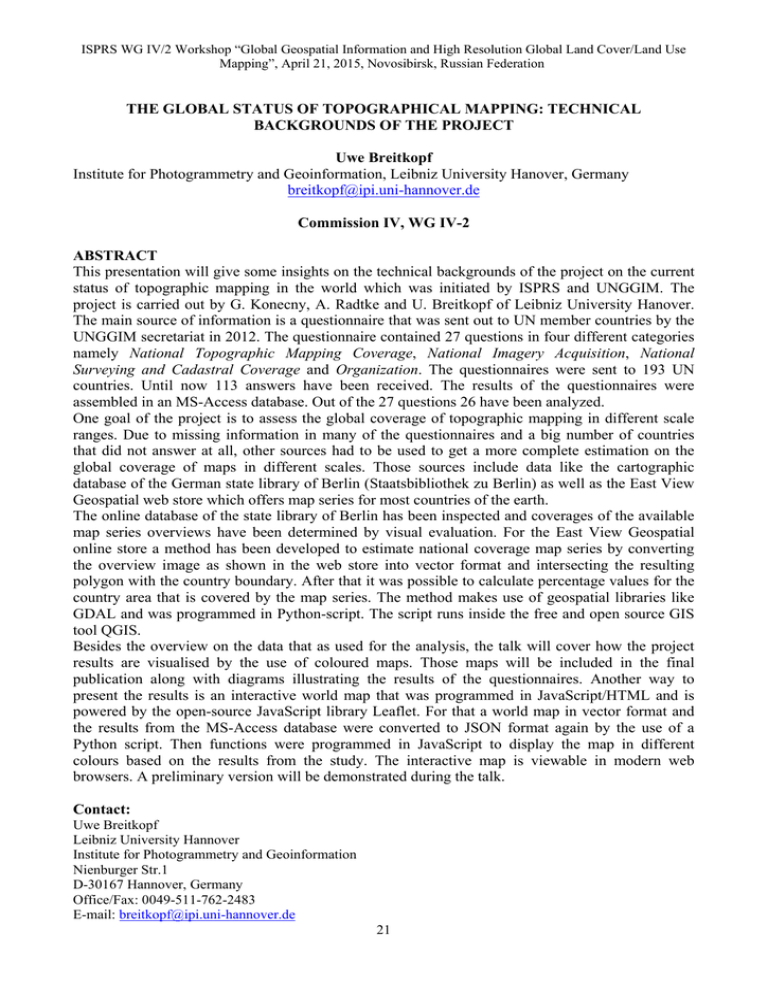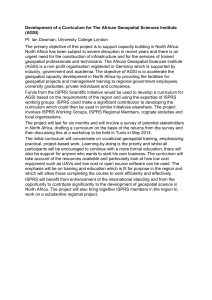Document 11840988
advertisement

ISPRS WG IV/2 Workshop “Global Geospatial Information and High Resolution Global Land Cover/Land Use Mapping”, April 21, 2015, Novosibirsk, Russian Federation THE GLOBAL STATUS OF TOPOGRAPHICAL MAPPING: TECHNICAL BACKGROUNDS OF THE PROJECT Uwe Breitkopf Institute for Photogrammetry and Geoinformation, Leibniz University Hanover, Germany breitkopf@ipi.uni-hannover.de Commission IV, WG IV-2 ABSTRACT This presentation will give some insights on the technical backgrounds of the project on the current status of topographic mapping in the world which was initiated by ISPRS and UNGGIM. The project is carried out by G. Konecny, A. Radtke and U. Breitkopf of Leibniz University Hanover. The main source of information is a questionnaire that was sent out to UN member countries by the UNGGIM secretariat in 2012. The questionnaire contained 27 questions in four different categories namely National Topographic Mapping Coverage, National Imagery Acquisition, National Surveying and Cadastral Coverage and Organization. The questionnaires were sent to 193 UN countries. Until now 113 answers have been received. The results of the questionnaires were assembled in an MS-Access database. Out of the 27 questions 26 have been analyzed. One goal of the project is to assess the global coverage of topographic mapping in different scale ranges. Due to missing information in many of the questionnaires and a big number of countries that did not answer at all, other sources had to be used to get a more complete estimation on the global coverage of maps in different scales. Those sources include data like the cartographic database of the German state library of Berlin (Staatsbibliothek zu Berlin) as well as the East View Geospatial web store which offers map series for most countries of the earth. The online database of the state library of Berlin has been inspected and coverages of the available map series overviews have been determined by visual evaluation. For the East View Geospatial online store a method has been developed to estimate national coverage map series by converting the overview image as shown in the web store into vector format and intersecting the resulting polygon with the country boundary. After that it was possible to calculate percentage values for the country area that is covered by the map series. The method makes use of geospatial libraries like GDAL and was programmed in Python-script. The script runs inside the free and open source GIS tool QGIS. Besides the overview on the data that as used for the analysis, the talk will cover how the project results are visualised by the use of coloured maps. Those maps will be included in the final publication along with diagrams illustrating the results of the questionnaires. Another way to present the results is an interactive world map that was programmed in JavaScript/HTML and is powered by the open-source JavaScript library Leaflet. For that a world map in vector format and the results from the MS-Access database were converted to JSON format again by the use of a Python script. Then functions were programmed in JavaScript to display the map in different colours based on the results from the study. The interactive map is viewable in modern web browsers. A preliminary version will be demonstrated during the talk. Contact: Uwe Breitkopf Leibniz University Hannover Institute for Photogrammetry and Geoinformation Nienburger Str.1 D-30167 Hannover, Germany Office/Fax: 0049-511-762-2483 E-mail: breitkopf@ipi.uni-hannover.de 21




